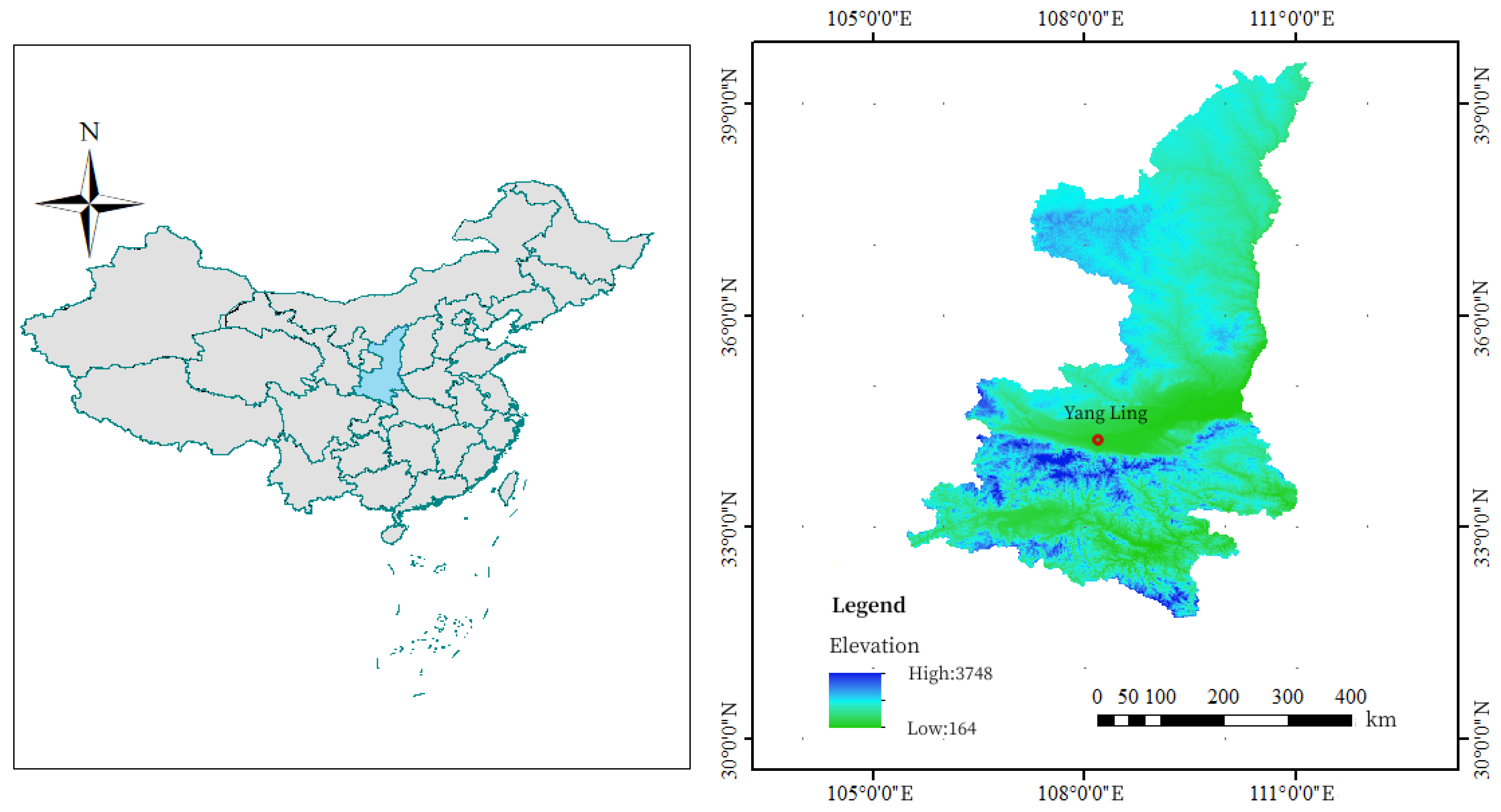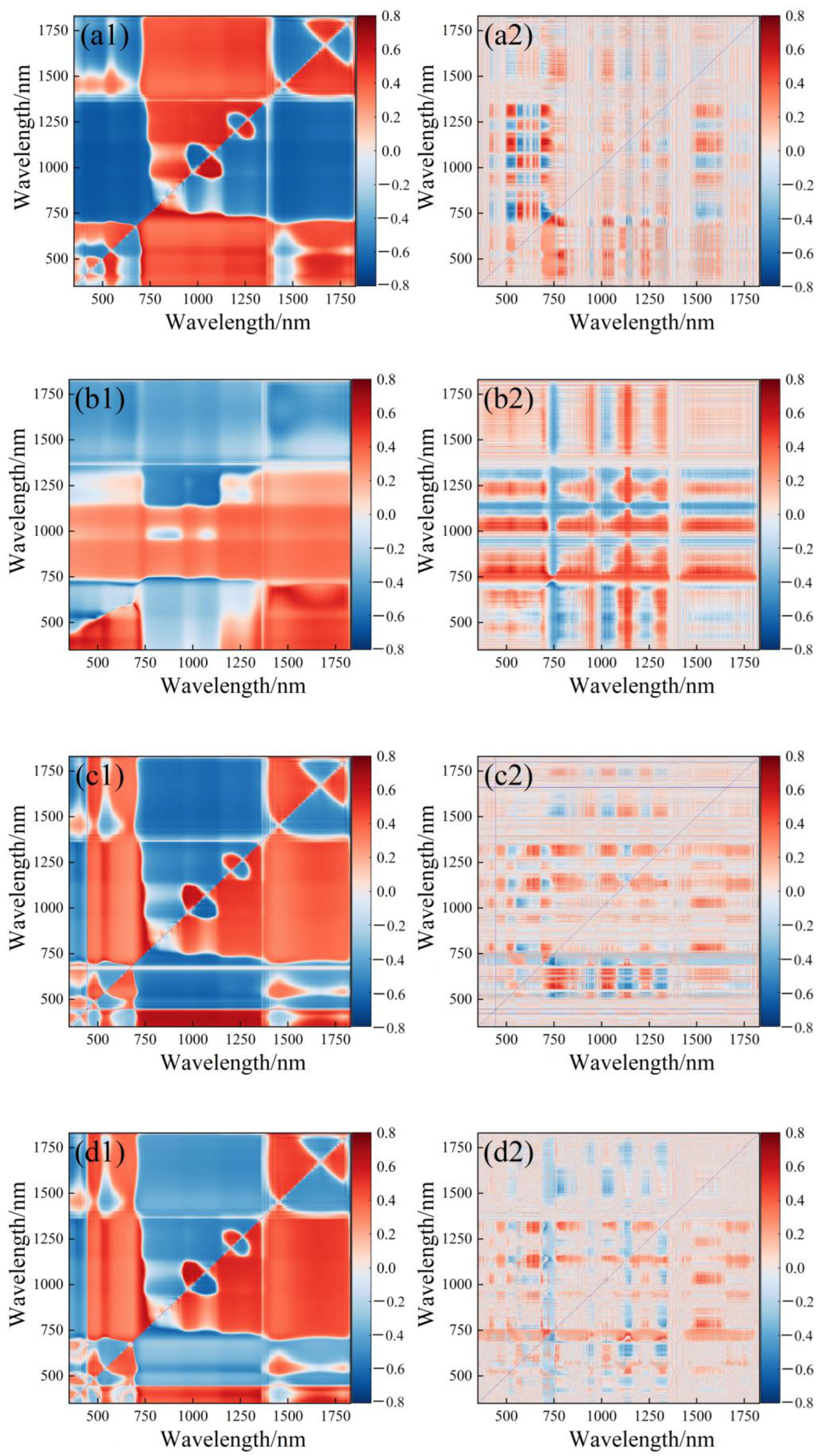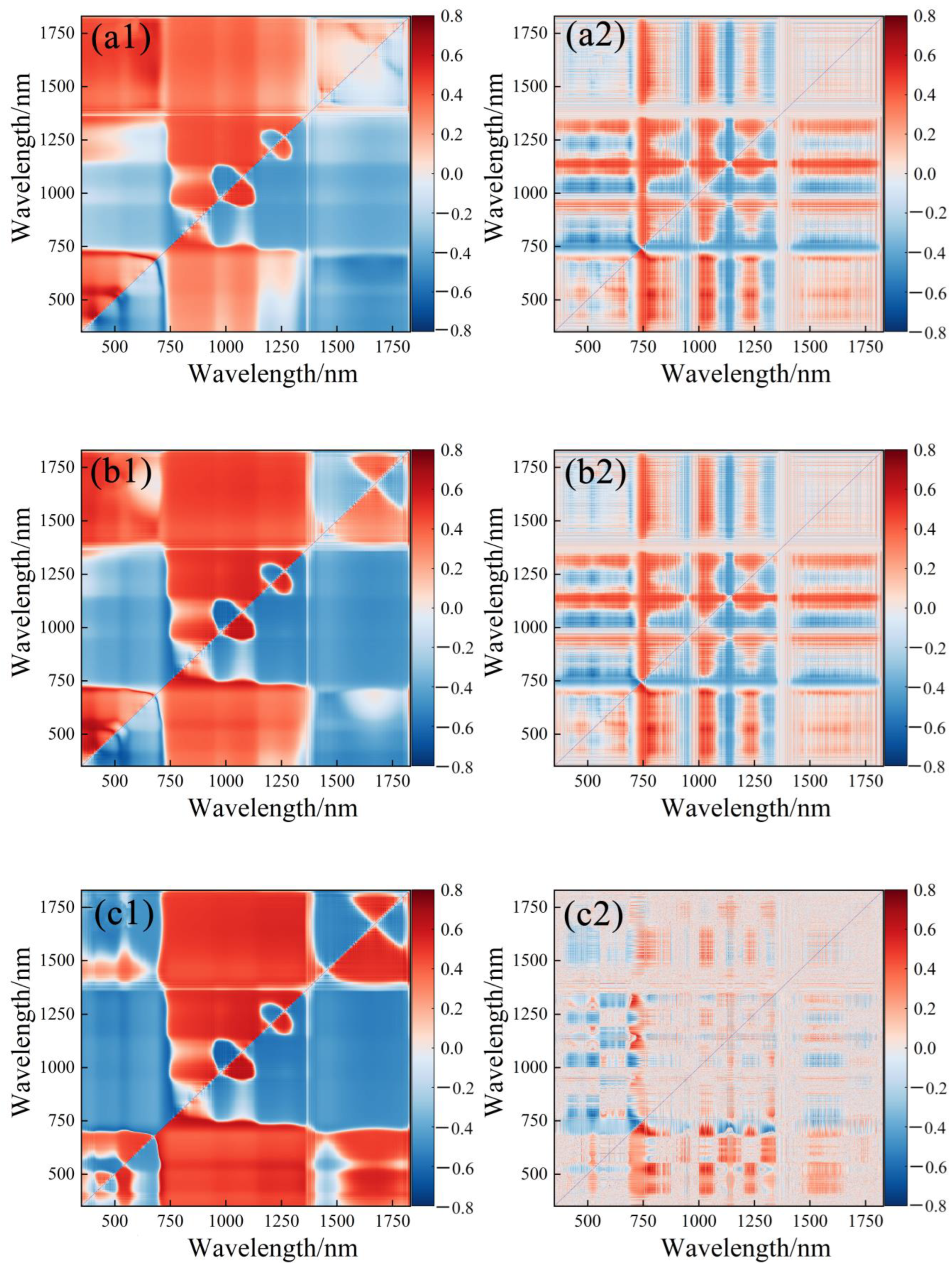Estimation of the Leaf Area Index of Winter Rapeseed Based on Hyperspectral and Machine Learning
Abstract
:1. Introduction
2. Materials and Methods
2.1. Overview of the Test Area
2.2. Data Acquisition and Processing
2.3. Hyperspectral Data Acquisition and Processing
2.4. Selection and Extraction of Vegetation Index
2.5. Modeling Technique
2.6. Data Processing and Model Evaluation
3. Results
3.1. Spectral Index Construction and Optimal Spectral Index Band Combination Extraction
3.2. Construction and Comparison of LAI Prediction Models for Winter Oilseed Rape
4. Discussion
5. Conclusions
Author Contributions
Funding
Data Availability Statement
Conflicts of Interest
References
- Li, J.; Zhou, Y.; Gu, H.; Lu, Z.; Cong, R.; Li, X.; Ren, T.; Lu, J. Synergistic effect of nitrogen and potassium on seed yield and nitrogen use efficiency in winter oilseed rape (Brassica napus L.). Eur. J. Agron. 2023, 148, 126875. [Google Scholar] [CrossRef]
- Stephenson, A.; Dennis, J.; Scott, S. Improving the sustainability of the production of biodiesel from oilseed rape in the UK. Process Saf. Environ. Prot. 2008, 86, 427–440. [Google Scholar] [CrossRef]
- Lu, X.; Wang, X.; Zhang, X.; Wang, J.; Yang, Z. Winter wheat leaf area index inversion by the genetic algorithms neural network model based on SAR data. Int. J. Digit. Earth 2022, 15, 362–380. [Google Scholar] [CrossRef]
- Casadesús, J.; Villegas, D. Conventional digital cameras as a tool for assessing leaf area index and biomass for cereal breeding. J. Integr. Plant Biol. 2014, 56, 7–14. [Google Scholar] [CrossRef]
- Pradhan, S.; Bandyopadhyay, K.K.; Sehgal, V.K.; Sahoo, R.N.; Panigrahi, P.; Krishna, G.; Gupta, V.K.; Joshi, D.K. Estimation of leaf chlorophyll content in wheat using hyperspectral vegetation indices. Curr. Sci. 2020, 119, 174–175. [Google Scholar]
- Lu, J.; Yang, T.; Su, X.; Qi, H.; Yao, X.; Cheng, T.; Zhu, Y.; Cao, W.; Tian, Y. Monitoring leaf potassium content using hyperspectral vegetation indices in rice leaves. Precis. Agric. Int. J. Adv. Precis. Agric. 2020, 21, 32. [Google Scholar] [CrossRef]
- Zhang, Z.; Lou, Y.; Ojara, A.M.; Li, R.; Ma, L.; Li, J. Hyperspectral vegetation indexes to monitor wheat plant height under different sowing conditions. Spectrosc. Lett. 2020, 53, 194–206. [Google Scholar]
- Qi, H.; Zhu, B.; Kong, L.; Yang, W.; Zou, J.; Lan, Y.; Zhang, L. Hyperspectral Inversion Model of Chlorophyll Content in Peanut Leaves. Appl. Sci. 2020, 10, 2259. [Google Scholar] [CrossRef]
- Li, C.; Cui, Y.; Ma, C.; Niu, Q.; Li, J. Hyperspectral inversion of maize biomass coupled with plant height data. Crop Sci. 2021, 61, 2067–2079. [Google Scholar] [CrossRef]
- Feng, S.; Xu, T.; Yu, F.; Chen, C.; Yang, X.; Wang, N. Research of Method for Inverting Nitrogen Content in Canopy Leaves of Japonica Rice in Northeastern China Based on Hyperspectral Remote Sensing of Unmanned Aerial Vehicle. Spectrosc. Spectr. Anal. 2018, 39, 3281–3287. [Google Scholar]
- Wang, R.; Song, X.; Li, Z.; Yang, G.; Guo, W.; Tan, C.; Chen, L. Estimation of winter wheat nitrogen nutrition index using hyperspectral remote sensing. Editor. Off. Trans. Chin. Soc. Agric. Eng. 2014, 30, 191–198. [Google Scholar]
- Farias, G.D.; Bremm, C.; Bredemeier, C.; Menezes, J.d.L.; Alves, L.A.; Tiecher, T.; Martins, A.P.; Fioravanço, G.P.; da Silva, G.P.; Carvalho, P.C.d.F. Normalized Difference Vegetation Index (NDVI) for soybean biomass and nutrient uptake estimation in response to production systems and fertilization strategies. Front. Sustain. Food Syst. 2023, 6, 959681. [Google Scholar] [CrossRef]
- Wang, X.; Cai, G.; Lu, X.; Yang, Z.; Zhang, X.; Zhang, Q. Inversion of Wheat Leaf Area Index by Multivariate Red-Edge Spectral Vegetation Index. Sustainability 2022, 14, 15875. [Google Scholar] [CrossRef]
- Wu, T.; Yu, J.; Lu, J.; Zou, X.; Zhang, W. Research on Inversion Model of Cultivated Soil Moisture Content Based on Hyperspectral Imaging Analysis. Agriculture 2020, 10, 292. [Google Scholar] [CrossRef]
- Xiang, Y.; Wang, X.; An, J.; Tang, Z.; Li, W.; Shi, H. Estimation of soybean leaf area index based on fractional differential and optimal spectral index. Trans. Chin. Soc. Agric. Mach. 2023, 54, 281–295. [Google Scholar]
- Abubakar, S.A.; Hamani, A.K.M.; Wang, G.; Liu, H.; Mehmood, F.; Abdullahi, A.S.; Gao, Y.; Duan, A. Growth and nitrogen productivity of drip-irrigated winter wheat under different nitrogen fertigation strategies in the North China Plain. J. Integr. Agric. 2023, 22, 908–922. [Google Scholar] [CrossRef]
- Tang, Z.; Guo, J.; Xiang, Y.; Lu, X.; Wang, Q.; Wang, H.; Cheng, M.; Wang, H.; Wang, X.; An, J.; et al. Estimation of Leaf Area Index and Above-Ground Biomass of Winter Wheat Based on Optimal Spectral Index. Agronomy 2022, 12, 1729. [Google Scholar] [CrossRef]
- Kerimkhulle, S.; Kerimkulov, Z.; Aitkozha, Z.; Saliyeva, A.; Taberkhan, R.; Adalbek, A. The estimate one-two-sided confidence intervals for mean of spectral reflectance of the vegetation. J. Phys. Conf. Ser. 2022, 2388, 012160. [Google Scholar] [CrossRef]
- Yang, H.; Cheng, Y.; Li, G. A denoising method for ship radiated noise based on Spearman variational mode decomposition, spatial-dependence recurrence sample entropy, improved wavelet threshold denoising, and Savitzky-Golay filter. Alex. Eng. J. 2021, 60, 3379–3400. [Google Scholar] [CrossRef]
- Zhang, X.; Zhang, Y.; Wang, M.; Liu, Y.; Wu, H.; Wang, K. An Analysis of Physiological Changes and Spectral Characteristics of Platanus occidentalis Leaves Infested by Corythucha ciliata (SAY) (Hemiptera:Tingidae). Forests 2023, 14, 449. [Google Scholar] [CrossRef]
- Chai, X. Parameters Based on UAV Remote Sensing Study on Inversion Method of Soybean Growth. Master’s Thesis, Shanxi Agricultural University, Jinzhong, China, 2023. [Google Scholar] [CrossRef]
- Xu, C.; Hu, X.; Chen, D.; Zhen, J.; Wang, W.; Peng, X.; Ru, C. Estimation of grape basal crop coefficient in northwestern semi-humid zone based on UAV multispectral remote sensing. Agric. Res. Arid. Areas 2023, 41, 106–117. [Google Scholar]
- Liu, S.; Yu, H.; Zhang, J.; Zhou, H.; Kong, L.; Zhang, L.; Dang, J.; Sui, Y. Study on Inversion Model of Chlorophyll Content in Soybean Leaf Based on Optimal Spectral Indices. Spectrosc. Spectr. Anal. 2021, 41, 1912–1919. [Google Scholar]
- Zhou, Y.; Zhang, S. Prediction of rupture and perforation limits of pressurised X80 pipelines using BP neural networks and generalised additive models. Ocean. Eng. 2022, 259, 111839. [Google Scholar] [CrossRef]
- Liu, L.; Gao, Y.; Wu, X.; Chang, T.; Li, Y.; Lv, J.; Jiang, D.; Zhao, B.; Wang, Z. A rapid origin identification method for Panax quinquefolius by terahertz spectroscopy combined with random forest. Optik 2022, 268, 169718. [Google Scholar] [CrossRef]
- Huang, H.; Wang, Z.; Chung, W. Efficient parameter selection for support vector machines. Enterp. Inf. Syst. 2019, 13, 916–932. [Google Scholar] [CrossRef]
- Shi, H.; Guo, J.; An, J.; Tang, Z.; Wang, X.; Li, W.; Zhao, X.; Jin, L.; Xiang, Y.; Li, Z.; et al. Estimation of Chlorophyll Content in Soybean Crop at Different Growth Stages Based on Optimal Spectral Index. Agronomy 2023, 13, 663. [Google Scholar] [CrossRef]
- Shen, W.; Wang, J.; Chen, M.; Hao, L.; Wu, Z. Research on Bathymetric Inversion Capability of Different Multispectral Remote Sensing Images in Seaports. Sensors 2023, 23, 1178. [Google Scholar] [CrossRef]
- Xu, D.; Liu, Y.; Xu, W.; Guo, X. The Impact of NPV on the Spectral Parameters in the Yellow-Edge, Red-Edge and NIR Shoulder Wavelength Regions in Grasslands. Remote Sens. 2022, 14, 3031. [Google Scholar] [CrossRef]
- Yang, Y.; Liao, J.; Li, H.; Tan, K.; Zhang, X. Identification of high-oil content soybean using hyperspectral reflectance and one-dimensional convolutional neural network. Spectrosc. Lett. 2023, 56, 28–41. [Google Scholar] [CrossRef]
- Kanako, M. Use of chlorophyll index-green and the red-edge chlorophyll index to derive an algorithm for estimating gross primary production capacity. Remote Sens. 2019, 11149, 54–61. [Google Scholar]
- Gao, S.; Guan, H.; Ma, X. A recognition method of multispectral images of soybean canopies based on neural network. Ecol. Inform. 2022, 68, 101538. [Google Scholar] [CrossRef]
- Deng, W.; Huang, Y.; Zhao, C.; Wang, X. Discrimination of Crop and Weeds on Visible and Visible/Near-Infrared Spectrums Using Support Vector Machine, Artificial Neural Network and Decision Tree. Sens. Transducers 2014, 26, 26–34. [Google Scholar]
- Li, J.; Yu, Y.; Wang, Y.; Zhao, L.; He, C. Prediction of Transient NOx Emission from Diesel Vehicles Based on Deep-Learning Differentiation Model with Double Noise Reduction. Atmosphere 2021, 12, 1702. [Google Scholar] [CrossRef]
- Yang, S.; Hu, L.; Wu, H.; Ren, H.; Qiao, H.; Li, P.; Fan, W. Integration of Crop Growth Model and Random Forest for Winter Wheat Yield Estimation from UAV Hyperspectral Imagery. IEEE J. Sel. Top. Appl. Earth Obs. Remote Sens. 2021, 14, 6253–6269. [Google Scholar] [CrossRef]
- Yang, Z.; Tian, J.; Wang, Z.; Feng, K. Monitoring the photosynthetic performance of grape leaves using a hyperspectral-based machine learning model. Eur. J. Agron. 2022, 140, 126589. [Google Scholar] [CrossRef]
- Kang, N.Y.; Go, S.Y.; Cho, G.S. A Comparative Study on Suitable SVM Kernel Function of Land Cover Classification Using KOMPSAT-2 Imagery. J. Korean Soc. Geospat. Inf. Syst. 2013, 21, 19–25. [Google Scholar]




| Statistical Indicators | LAI/(cm2/cm2) |
|---|---|
| Sample size | 64 |
| Maximum value | 5.46 |
| Minimum value | 1.88 |
| Average value | 3.65 |
| Standard deviation | 0.99 |
| Coefficient of variation/% | 0.27 |
| Spectral Index | Calculation Formula | Reference |
|---|---|---|
| Ratio vegetation index (RI) | [20] | |
| Triangle vegetation index (TVI) | [20] | |
| Modified simple ratio (mSR) | [21] | |
| Modified normalized difference index (mNDI) | [21] | |
| Difference vegetation index (DI) | − | [22] |
| Soil adjustment vegetation index (SAVI) | [22] | |
| Normalized difference vegetation index (NDVI) | [23] |
| Differential Order | Spectral Index | Correlation Coefficient | Position of Wavelength (i,j)/(nm) | Spectral Index Combination |
|---|---|---|---|---|
| 0 | DI | 0.692 | 629,670 | RI, NDVI, mSR, mNDI, SAVI |
| RI | 0.714 | 748,749 | ||
| NDVI | 0.714 | 748,749 | ||
| SAVI | 0.701 | 685,670 | ||
| TVI | 0.664 | 760,736 | ||
| mSR | 0.715 | 749,748 | ||
| mNDI | 0.707 | 750,748 | ||
| 1 | DI | 0.709 | 717,753 | DI, RI, SAVI, TVI, NDVI |
| RI | 0.734 | 716,724 | ||
| NDVI | 0.734 | 716,724 | ||
| SAVI | 0.709 | 717,753 | ||
| TVI | 0.721 | 755,725 | ||
| mSR | 0.675 | 728,708 | ||
| mNDI | 0.702 | 728,708 |
| Different Order | Evaluating Indicator | BPNN | RF | SVM | |||
|---|---|---|---|---|---|---|---|
| Modeling Set | Validation Set | Modeling Set | Validation Set | Modeling Set | Validation Set | ||
| 0 | R2 | 0.646 | 0.541 | 0.535 | 0.559 | 0.496 | 0.701 |
| RMSE | 0.569 | 0.684 | 0.522 | 0.722 | 0.758 | 0.410 | |
| MRE | 12.083 | 12.872 | 15.749 | 18.368 | 12.87 | 8.845 | |
| 1 | R2 | 0.650 | 0.639 | 0.705 | 0.810 | 0.738 | 0.630 |
| RMSE | 0.455 | 0.599 | 0.725 | 0.455 | 0.488 | 0.662 | |
| MRE | 11.721 | 15.064 | 14.562 | 10.465 | 7.596 | 15.853 | |
Disclaimer/Publisher’s Note: The statements, opinions and data contained in all publications are solely those of the individual author(s) and contributor(s) and not of MDPI and/or the editor(s). MDPI and/or the editor(s) disclaim responsibility for any injury to people or property resulting from any ideas, methods, instructions or products referred to in the content. |
© 2023 by the authors. Licensee MDPI, Basel, Switzerland. This article is an open access article distributed under the terms and conditions of the Creative Commons Attribution (CC BY) license (https://creativecommons.org/licenses/by/4.0/).
Share and Cite
Zhang, W.; Li, Z.; Pu, Y.; Zhang, Y.; Tang, Z.; Fu, J.; Xu, W.; Xiang, Y.; Zhang, F. Estimation of the Leaf Area Index of Winter Rapeseed Based on Hyperspectral and Machine Learning. Sustainability 2023, 15, 12930. https://doi.org/10.3390/su151712930
Zhang W, Li Z, Pu Y, Zhang Y, Tang Z, Fu J, Xu W, Xiang Y, Zhang F. Estimation of the Leaf Area Index of Winter Rapeseed Based on Hyperspectral and Machine Learning. Sustainability. 2023; 15(17):12930. https://doi.org/10.3390/su151712930
Chicago/Turabian StyleZhang, Wei, Zhijun Li, Yang Pu, Yunteng Zhang, Zijun Tang, Junyu Fu, Wenjie Xu, Youzhen Xiang, and Fucang Zhang. 2023. "Estimation of the Leaf Area Index of Winter Rapeseed Based on Hyperspectral and Machine Learning" Sustainability 15, no. 17: 12930. https://doi.org/10.3390/su151712930







